Activism
Three days of protest spark mixed reactions — Oaklanders question who is behind the destruction.
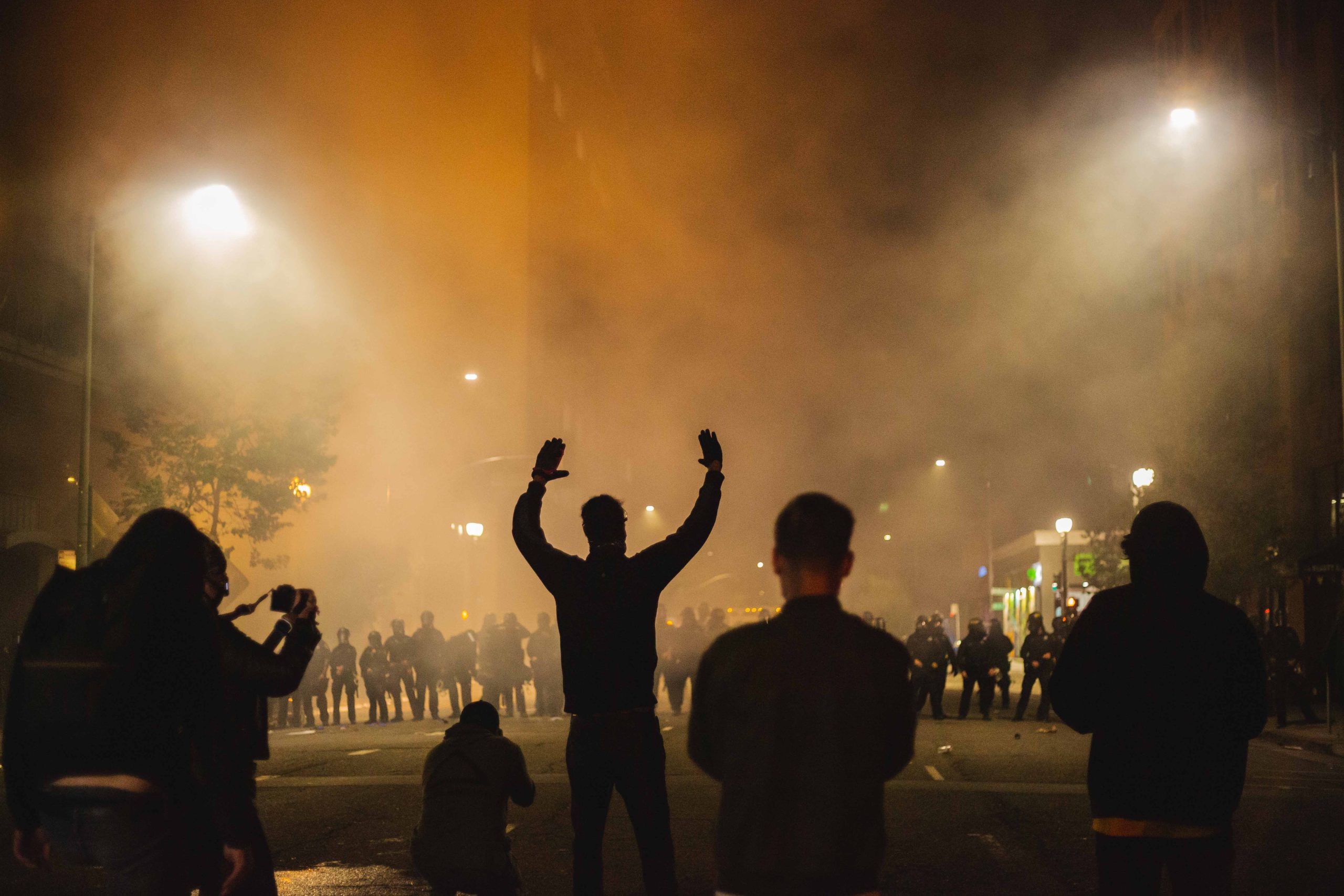
Thousands of people took to the Oakland streets May 29 for what was at first a peaceful protest against the death of George Floyd, who died after a Minneapolis police officer knelt on his neck for nine minutes.
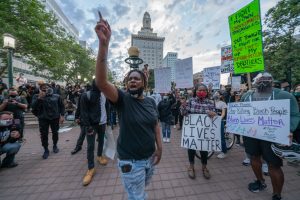
A protester named Taylor spoke to an energized growing crowd as attendees chant “No justice no peace!” Photo by Michelle Snider.
After nightfall, a crowd attempted to gain access to the 880 freeway, throwing water bottles at police officers and launching a flare that started a small grass fire. Others headed towards the Oakland Police Department (OPD) building on Broadway and took a knee as they were met with a line of police officers.
OPD swiftly deemed the protest an “unlawful gathering” and allowed three minutes for protesters to disperse before launching tear-gas, and later rubber bullets.
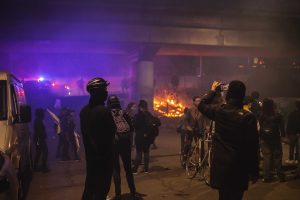
A crowd attempts to gain access to the 880 freeway. A flare was launched by the crowd and started a small grass fire. Photo by Saskia Hatvany.
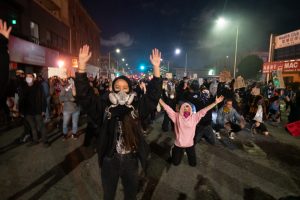
Protesters kneel with hands in the air in as police start to throw tear gas in their direction. Photo by Michelle Snider.
Meanwhile, several small groups split off and proceeded to break the windows of Chase, Wells Fargo and other businesses. Trash cans were dragged into the streets and some were set ablaze.
By 11 p.m. Twitter was filled with videos of looting and fires in the Downtown Oakland area. Walgreens on Broadway was looted and there were reports of a small fire inside. CVS on Broadway was also looted, and the city center Starbucks was set on fire.
A Honda CR-V was driven off the Honda of Oakland showroom in front of a large crowd, and the brand new Target on Broadway was smashed up, looted, and is now to be closed indefinitely.
Last night they were just driving out cars out the showroom out of Honda in Oakland. America be entertaining #ICantBreathe #anonymus #RIPGeorgeFloyd pic.twitter.com/73TJaxkOPx
— 𝕁𝕖𝕣𝕖𝕞𝕪 𝕄𝕠𝕣𝕖 (@Jeremy_More) June 1, 2020
Later that night, two federal officers were shot on guard at the Ronald V. Dellums Federal Building at 1301 Clay St. One of them, Dave Patrick Underwood, succumbed to his injuries and died.
The shooting was called an “an act of domestic terrorism,” by Department of Homeland Security Acting Deputy Secretary Ken Cuccinelli at a Washington, D.C., news conference. But on Saturday California Gov. Gavin Newsom warned that the shooting should not be quickly associated with the acts of peaceful protesters. “No one should rush to conflate this heinous act with the protests last night,” he said.
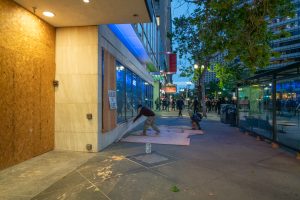
On the corner of 14th and Broadway the boarded up windows of Chase are being removed
On Twitter, some were outraged at the looting and highlighted that the protests were mostly peaceful. A Chamber of Commerce representative said Saturday that “a small band of well-mobilized vandals” had once again targeted the city’s merchants and most vulnerable people.
“We will not let out-of-town individuals undermine this legitimate protest and destroy our local economy,” said Barbara Leslie, President, and CEO of the Oakland Metropolitan Chamber of Commerce.
More of what happened at the start of the looting in Oakland last night. I was there throughout the night, same narrative, white people inciting the violence and break-ins. They did not come here to protest, they did not come here for us. #OaklandProtest #GeorgeFloyd #BLM pic.twitter.com/wuXSOmF3gj
— peanut butter cup (@deshawnieboy) May 30, 2020
Most businesses targeted were corporate, but some black-owned and smaller businesses were targeted as well, including Queen Hippe Gypsy, a small shop owned by Lillianna Ayers — a black woman, which only solidified claims that some of the rioters were not aligned with the protesters.
The looting continued throughout the weekend in Downtown Oakland, Emeryville and the Fruitvale area, leading local officials to impose an 8 p.m. curfew. Several peaceful daytime protests also occurred, including a caravan of over 1,000 cars around Lake Merritt, and a march beginning at Okland Tech and ending at the Oakland Police Department on Monday.
View our May 29 Photo Gallery:
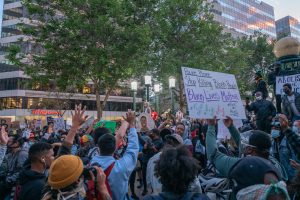
Protesters who met at Frank Ogawa Plaza in Oakland prepare to march down Broadway. Photo by Michelle Snider.
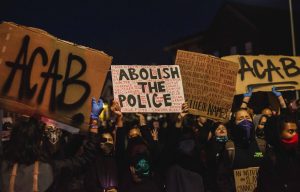
Protesters march through Oakland Chinatown bearing signs that read “ACAB” — which stands for “All cops are bad.” Photo by Saskia Hatvany.

A protester faces a line of OPD blocking the 880 Freeway entrance in Chinatown, Oakland. Photo by Saskia Hatvany.
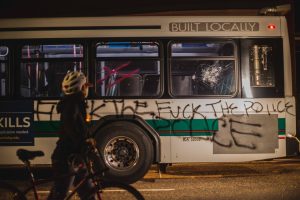
A protester walks by a moving city bus which was vandalized and mounted by rioters moments earlier. Photo by Saskia Hatvany.
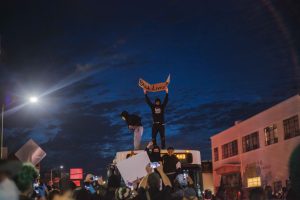
rotesters mount a moving city bus. Photo by Saskia Hatvany.
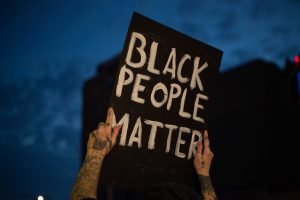

On the corner of 14th and Broadway the boarded up windows of Chase are being removed.
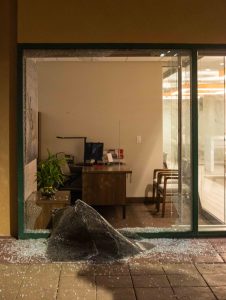
Shattered windows in Downtown Oakland. Photo by Saskia Hatvany.
https://twitter.com/daviddebolt/status/1266597457267326977?s=20
https://twitter.com/tariqnasheed/status/1266645980549611521?s=20
https://twitter.com/daviddebolt/status/1266623435884486662?s=20
https://twitter.com/Liam_ODonoghue/status/1266598909318541313?s=20
Activism
Oakland Post: Week of May 21 – 27, 2025
The printed Weekly Edition of the Oakland Post: Week of May 21 – 27, 2025

To enlarge your view of this issue, use the slider, magnifying glass icon or full page icon in the lower right corner of the browser window.
Activism
OPINION: Your Voice and Vote Impact the Quality of Your Health Care
One of the most dangerous developments we’re seeing now? Deep federal cuts are being proposed to Medicaid, the life-saving health insurance program that covers nearly 80 million lower-income individuals nationwide. That is approximately 15 million Californians and about 1 million of the state’s nearly 3 million Black Californians who are at risk of losing their healthcare.

By Rhonda M. Smith, Special to California Black Media Partners
Shortly after last year’s election, I hopped into a Lyft and struck up a conversation with the driver. As we talked, the topic inevitably turned to politics. He confidently told me that he didn’t vote — not because he supported Donald Trump, but because he didn’t like Kamala Harris’ résumé. When I asked what exactly he didn’t like, he couldn’t specifically articulate his dislike or point to anything specific. In his words, he “just didn’t like her résumé.”
That moment really hit hard for me. As a Black woman, I’ve lived through enough election cycles to recognize how often uncertainty, misinformation, or political apathy keep people from voting, especially Black voters whose voices are historically left out of the conversation and whose health, economic security, and opportunities are directly impacted by the individual elected to office, and the legislative branches and political parties that push forth their agenda.
That conversation with the Lyft driver reflects a troubling surge in fear-driven politics across our country. We’ve seen White House executive orders gut federal programs meant to help our most vulnerable populations and policies that systematically exclude or harm Black and underserved communities.
One of the most dangerous developments we’re seeing now? Deep federal cuts are being proposed to Medicaid, the life-saving health insurance program that covers nearly 80 million lower-income individuals nationwide. That is approximately 15 million Californians and about 1 million of the state’s nearly 3 million Black Californians who are at risk of losing their healthcare.
Medicaid, called Medi-Cal in California, doesn’t just cover care. It protects individuals and families from medical debt, keeps rural hospitals open, creates jobs, and helps our communities thrive. Simply put; Medicaid is a lifeline for 1 in 5 Black Americans. For many, it’s the only thing standing between them and a medical emergency they can’t afford, especially with the skyrocketing costs of health care. The proposed cuts mean up to 7.2 million Black Americans could lose their healthcare coverage, making it harder for them to receive timely, life-saving care. Cuts to Medicaid would also result in fewer prenatal visits, delayed cancer screenings, unfilled prescriptions, and closures of community clinics. When healthcare is inaccessible or unaffordable, it doesn’t just harm individuals, it weakens entire communities and widens inequities.
The reality is Black Americans already face disproportionately higher rates of poorer health outcomes. Our life expectancy is nearly five years shorter in comparison to White Americans. Black pregnant people are 3.6 times more likely to die during pregnancy or postpartum than their white counterparts.
These policies don’t happen in a vacuum. They are determined by who holds power and who shows up to vote. Showing up amplifies our voices. Taking action and exercising our right to vote is how we express our power.
I urge you to start today. Call your representatives, on both sides of the aisle, and demand they protect Medicaid (Medi-Cal), the Affordable Care Act (Covered CA), and access to food assistance programs, maternal health resources, mental health services, and protect our basic freedoms and human rights. Stay informed, talk to your neighbors and register to vote.
About the Author
Rhonda M. Smith is the Executive Director of the California Black Health Network, a statewide nonprofit dedicated to advancing health equity for all Black Californians.
Activism
OPINION: Supreme Court Case Highlights Clash Between Parental Rights and Progressive Indoctrination
At the center of this controversy are some parents from Montgomery County in Maryland, who assert a fundamental principle: the right to shield their children from exposure to sexual content that is inappropriate for their age, while also steering their moral and ethical upbringing in alignment with their faith. The local school board decided to introduce a curriculum that includes LGBTQ+ themes — often embracing controversial discussions of human sexuality and gender identity.

By Craig J. DeLuz, Special to California Black Media Partners
In America’s schools, the tension between parental rights and learning curricula has created a contentious battlefield.
In this debate, it is essential to recognize that parents are, first and foremost, their children’s primary educators. When they send their children to school — public or private — they do not surrender their rights or responsibilities. Yet, the education establishment has been increasingly encroaching on this vital paradigm.
A case recently argued before the Supreme Court regarding Maryland parents’ rights to opt out of lessons that infringe upon their religious beliefs epitomizes this growing conflict. This case, Mahmoud v. Taylor, is not simply about retreating from progressive educational mandates. It is fundamentally a defense of First Amendment rights, a defense of parents’ rights to be parents.
At the center of this controversy are some parents from Montgomery County in Maryland, who assert a fundamental principle: the right to shield their children from exposure to sexual content that is inappropriate for their age, while also steering their moral and ethical upbringing in alignment with their faith. The local school board decided to introduce a curriculum that includes LGBTQ+ themes, often embracing controversial discussions of human sexuality and gender identity. The parents argue that the subject matter is age-inappropriate, and the school board does not give parents the option to withdraw their children when those lessons are taught.
This case raises profound questions about the role of public education in a democratic society. In their fervent quest for inclusivity, some educators seem to have overlooked an essential truth: that the promotion of inclusivity should never infringe upon parental rights and the deeply held convictions that guide families of different faith backgrounds.
This matter goes well beyond mere exposure. It veers into indoctrination when children are repeatedly confronted with concepts that clash with their family values.
“I don’t think anybody can read that and say: well, this is just telling children that there are occasions when men marry other men,” noted Justice Samuel Alito. “It has a clear moral message, and it may be a good message. It’s just a message that a lot of religious people disagree with.”
Justice Amy Coney Barrett raised a crucial point, noting that it is one thing to merely expose students to diverse ideas; it is quite another to present certain viewpoints as indisputable truths. By framing an ideology with the certainty of “this is the right view of the world,” educators risk indoctrination rather than enlightenment. This distinction is not merely academic; it speaks to the very essence of cultivating a truly informed citizenry.
Even Justice Elena Kagan expressed concern regarding the exposure of young children to certain materials in Montgomery County.
“I, too, was struck by these young kids’ picture books and, on matters concerning sexuality, I suspect there are a lot of non-religious parents who weren’t all that thrilled about this,” she said.
Justice John Roberts aptly questioned the practicality of expecting young children to compartmentalize their beliefs in the classroom.
“It is unreasonable to expect five-year-olds, still forming their worldviews, to reconcile lessons that conflict fundamentally with the teachings they receive at home,” he said.
As was noted in my previous commentary, “The Hidden Truth In The Battle Over Books In American Schools”, what lies at the heart of these debates is a moral disconnect between the values held by the majority of Americans and those promoted by the educational establishment. While the majority rightly argue that material containing controversial content of a sexual nature should have no place in our children’s classrooms, the education establishment continues to tout the necessity of exposing children to such content under the guise of inclusivity. This disregards the legitimate values held by the wider community.
Highlighted in this case that is before the Supreme Court is a crucial truth: parents must resolutely maintain their right to direct their children’s education, according to their values. This struggle is not simply a skirmish; it reflects a broader movement aimed at reshaping education by privileging a state-sanctioned narrative while marginalizing dissenting voices.
It is imperative that we assert, without hesitation, that parents are — and must remain — the primary educators of their children.
When parents enroll a child in a school, it should in no way be interpreted as a relinquishment of parental authority or the moral guidance essential to their upbringing. We must stand firm in defending parental rights against the encroaching ideologies of the education establishment.
About the Author
Craig J. DeLuz has almost 30 years of experience in public policy and advocacy. He has served as a member of The Robla School District Board of Trustees for over 20 years. He also currently hosts a daily news and commentary show called “The RUNDOWN.” You can follow him on X at @CraigDeLuz.
-

 #NNPA BlackPress3 weeks ago
#NNPA BlackPress3 weeks agoMLK Bust Quietly Removed from Oval Office Under Trump
-

 Activism4 weeks ago
Activism4 weeks agoOakland Post: Week of April 30 – May 6, 2025
-

 Activism3 weeks ago
Activism3 weeks agoOakland Post: Week of May 7 – 13, 2025
-

 #NNPA BlackPress3 weeks ago
#NNPA BlackPress3 weeks agoTrump Abruptly Fires First Carla Hayden: The First Black Woman to Serve as Librarian of Congress
-

 Activism2 weeks ago
Activism2 weeks agoNew Oakland Moving Forward
-

 Activism2 weeks ago
Activism2 weeks agoAfter Two Decades, Oakland Unified Will Finally Regain Local Control
-

 Activism2 weeks ago
Activism2 weeks agoOakland Post: Week of May 14 – 20, 2025
-

 Alameda County2 weeks ago
Alameda County2 weeks agoOakland Begins Month-Long Closure on Largest Homeless Encampment

















































